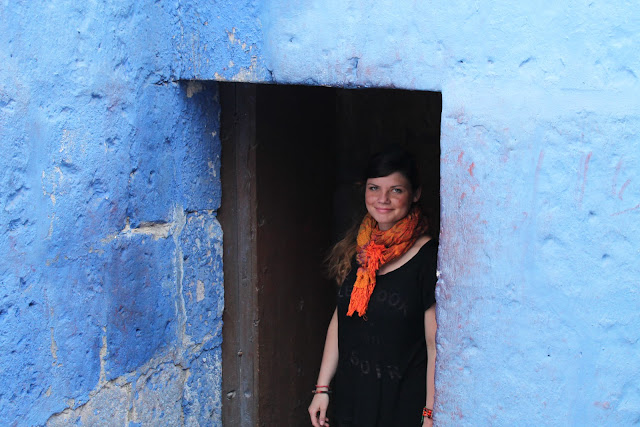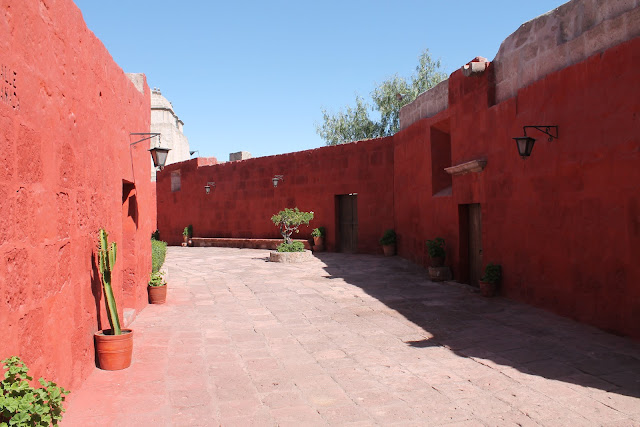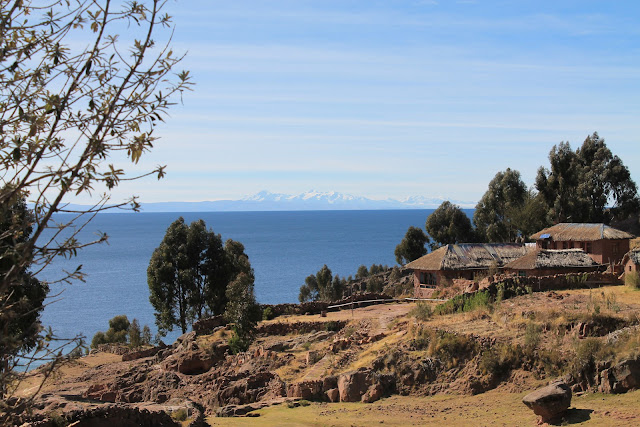Peru Adventure
wtorek, 2 lipca 2013
Arequipa. Peru´s second-largest city
Arequipa is famous for its spectacular Cañón del Colca. This 100km - long canyon is set among high volcanoes. 6613m - high Coropuna and 6310m - high Ampato. It is said that Cañón del Colca is more than twice as deep as the Grand Canyon in the USA. Unfortunately, we did not have enough time to go there. However, we still enjoyed Arequipa its colonial buildings, mysterious churches and location at the foot of the volcanoes.
We visited Santa Catalina Convent which was one of the most fascinating religious buildings we have ever seen. It was founded in 1580 by a rich widow - Dona Maria de Guzman. Nowadays visitors can see how nuns used to live hundreds years ago. The convent is also famous because of the sister Ana de Los Angeles Monteagudo. She was beatified by Pope John Paul II. Local people believe that the various miracles and predictions are attributed to her. In the convent you can find a book where you can place wishes.
We also visited Museo Santuarios Andinos Universidad Catolica De Santa Maria. Museum keeps one of the most interesting mummies in the world - Juanita. A young girl of the Ampato volcano - was discovered in 1995 by anthropologist Dr. Johan Reinhard. It is believed that Juanita was offered to the Inca god by the Inca priests of those days. She was between 12-14 years old at the moment of her death. This discovery is crucial for our knowledge about Incas life, because Juanita´s well preserved body provides interesting information about for example: type of diet and illnesses. Unfortunately, taking photos was forbidden at the museum. The photo is taken from: https://blogger.googleusercontent.com/img/b/R29vZ2xl/AVvXsEhXTVj-4is71BUQCUNS-BzjtEk0scdw3glqC2P_HedYi3FCovtmaubTcxz280B6TmD0nvVe1cDyZn45W-w23OIgJrJ6UtM4ZZaOGUfdDLpgu78c4tWXB7gj-_nJ5XnI0hOqTvfTIj23HdFX/s1600/Juanita+Mummy.jpg
As in each Peruvian city you can find colorful local markets where you can taste and buy delicious and fresh goods...
Eating some snacks with our new friend Anne;)
Believe us that everything in your life happens for a reason. We wanted to book one-day trip to Colca Canyon and in the one, of many agencies, called ´Colca Trek´ we met truly amazing person - Vlado. Although he said it is too dangerous to take one day trip (because it takes 15 hours and the road is covered by snow) he recommended other activities around the city. Then it turned out that Vlado is Honorary Consul of Poland;) He told us some great stories about Polish people who had and still have a great influence on the history not only of Arequipa but the whole Peru...
czwartek, 27 czerwca 2013
Inti Raymi - Cuzco
During the Inca Empire the Inti Raymi (festival of the sun) was one of the most important ceremonies in honor of the god Inti. Nowadays the celebration is held every 24th of June and brings thousands of tourists to Cuzco. Today it is the second largest festival in the South America. Hundreds of actors are chosen to represent historical figures. During this time Cuzco is even more colorful than usual. You can observe people dancing on the streets, fireworks and street fairs.
You can find local "snacks" like cuyo (guinea pig)
Pisco Sour is a typical cocktail of Peru.
It is a combination of Pisco, key lime (or lemon), egg white, angostura bitters and ice. Delicious ;) ¡Salud!
Puno - Titicaca Lake
The lake is located on the border between Bolivia and Peru. The name comes from Quechua language, Titi means puma while caca means rock. Local people claim that the shape of the lake reminds them a puma hunting a rabbit. Titicaca is the highest navigable lake in the world but it's famous for its numerous islands where life is still unchanged by modern world. We had an opportunity to visit three of them.
The first island was Taquile. It is a tiny island with a population of about 2000 people. Taquile is known for its handicrafts tradition. Their textile art is considered by UNESCO as Masterpieces of the Oral and Intangible Heritage of Humanity.
The old rituals and traditions are still very important here. They mainly use traditional medicine and women give birth at home supported by the local midwife.
Alex making a traditional shampoo :) he says: "my shampoo may even compete with Head&Shoulders"
People here run their society using the Inca moral code with three main rules: do not steal, do not lie, do not be lazy. Divorce is also not permitted on the island.
On the Taquile island we visited a typical house of weavers and saw beautiful sandy beach.
Llachon - cross-cultural experience with the local community and traditional lunch - Pachamanca (meals prepared on the earth)
Pachamanca is typical Andean dish. The name is made of two Quechua roots: pacha - earth and manca - pot. Local people heat up stones over the fire and place meat on the top. Then the fire is covered by grass and earth. Food is ready after three hours. Usually they cook chicken, lamb, pork, fish , guinea pig, lima beans, potatoes and corn humitas. However pachamanca isn't simple method of cooking, it is ritual itself. Before eating the local authority thanks mother earth and lake for giving food to the community.
Uros - reed islands.
The Uros are a pre-Incan people who live on floating islands. They make them by themselves using the buoyant totora reeds that grow in the shallows of the lake. The Uros is a small tribe living in their old way. However it doesn't mean that they reject modern technology at all. On the island you can see solar panels, tv or boats with motors. People are happy and smiling all the time (because they don't have to pay taxes ;)).
On the way back our guide offered us a a glass of pisco ;)
Subskrybuj:
Posty (Atom)









































































